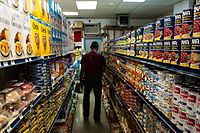
Photo from wikipedia
Abstract A spatial concentration of basic services can be observed in many European regions. This concentration is a result of the interaction between socio-economic and demographic processes. Rural regions in… Click to show full abstract
Abstract A spatial concentration of basic services can be observed in many European regions. This concentration is a result of the interaction between socio-economic and demographic processes. Rural regions in Germany are particularly affected by concentration processes and the thinning-out of services. Even though this topic is covered and debated in media, among policy makers and regional scientists, few reliable data exist on the dimensions and consequences of these processes. Food retailing is one subject area wherein a spatial concentration can be observed and its consequences have a direct impact. Different aspects of the spatial concentration processes in food retailing are the core of this article, which aims to address the following questions: Can spatial food deserts (regions with limited access to affordable and nutritious food) be identified in rural Germany, and, if yes, which part of the population seems to be particularly affected by insufficient access to food? Food deserts are approached at the macro level utilising a distance-based concept building on a GIS accessibility model. Thus, the focus is on the analysis of the potential general spatial existence of food deserts, not on individual consumer perspectives, behaviours, capabilities, or consequences. The results of the analysis reveal that in Germany, transportation availability is a decisive factor determining if one lives in a food desert or not. Furthermore, living in a food desert is more of an individual experience that depends on individual living conditions and capabilities than a spatial distinct phenomenon. However, as the accessibility to food retail stores is comparatively worse in connected parts of Mecklenburg-West Pomerania, Brandenburg, Rhineland-Palatinate and the north of Saxony-Anhalt, less mobile people living in these areas are more likely to experience food desert.
Journal Title: Journal of Rural Studies
Year Published: 2021
Link to full text (if available)
Share on Social Media: Sign Up to like & get
recommendations!